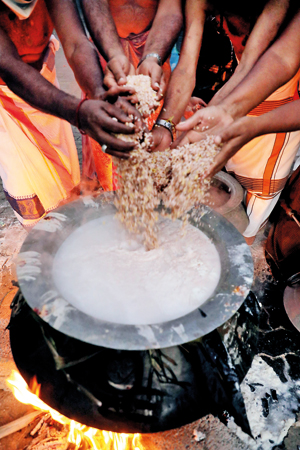Harvest feast in the season of the sun
It’s Thai Pongal. The harvest festival celebrated by millions of Hindu Tamils the world over when the Sun enters the constellation of Capricorn on January 14. With the Sun as the epicentre, Thai Pongal is the tenth month in the Hindu calendar. Pongal simply means to boil over. But in people’s hearts it means to brim with prosperity.

Wishes for prosperity in age-old rituals. Pic by M.A. Pushpa Kumara
The Thai Pongal festival spans four days. In Lanka however, the festival is celebrated mainly on its second day, the most important day, Surya Pongal or Perum Pongal, the day of thanksgiving to the deities for the rich bounty of the land, a day of prayer and rejoicing.
The first day of Pongal is called Bhogi. The day for spring cleaning. The home is spruced up, made spick and span; the floor is washed with turmeric mixed in water. Mango leaves, as an antiseptic to ward off germs, are hung at the entrance to welcome the second day, Surya Pongal,
But even before Surya Pongal dawns, the whole household’s astir. All attend to their assigned tasks. The men are busy packing up the kovil gifts of rice while the women are painting on the floor – the distinctive decorative art called kolam.
Coloured rice mixed with clay is used to draw the designer Pongal motif of the household. A square on the floor at the main entrance to the home is first chosen. Once a theme relevant to Thai Pongal has been decided on, expert artistic hands draw it. All the offerings the family makes to the Sun God are kept within this colourful motif. The kolam is drawn and the gifts are placed in such a way so that the rays of the early morn sun fall directly on it.
Within this colourful motif, pride of place is given for the firewood hearth that will soon be lit for the family pot of milk to brim and spill. Then, with the rising sun, when the auspicious hour arrives, all gather around the makeshift hearth as the matriarch of the home lights the family fire.
The fire is lit, the fire is kindled, and as the flames sway to bring the milk to a boil, silent prayers from anxious hearts rise brimming with hopes. The family relief is visible when the fire crackles cheerily; and the joy audible when the roused milk, in its lunge to a crescendo, dances, bubbles and finally leaps out to make the family fortunes awash with prosperity.
With hearts brimming with joy, all rejoice in the advent of Thai Pongal. As kovil bells ring and conches boom in the distant air, all cry ‘Pongal, Pongal’ and raise their hands in worship to the Sun God in his celestial abode.
The household lamp is lit and a tray of choice offerings of the family feast is made to Surya. Thereafter the celebrations start. The family share the traditional Pongal meal of white, yellow or red coloured rice, accompanied with a sambal. The spicy curry, cooked with herbs and condiments, consists of dhal, brinjals, drumsticks and pumpkin and served with vadais, papadams and murukku. And for dessert, it is milk rice cooked with jaggery, raisins and cashew nuts, known as Pongal rice.
Gifts are exchanged and songs of praise to the Gods are sung, after which they proceed to the kovil. The rest of the day is spent visiting friends and relations and receiving visits from them.
The third day of Thai Pongal is dedicated to cattle that have worked as partners in the field to bring home the seasonal rice. It’s called Maattu Pongal. In Sri Lanka, this is celebrated mainly in the villages. The animals are bathed and groomed, their horns brightly painted, their necks garlanded and their stomachs sated with a rich offering of the Pongal feast. It is also a day for revelry and races as men race their bulls against one another. Jallikattu, as the sport is called, hails from the ancient courts of Tamil kings.
A popular Pongal myth behind the festivities holds that Lord Shiva sent his bull Nandi to earth with a message to mankind. Have a gingelly oil massage and bathe daily and eat once a month. Nandi, however, got his horns in a twist and told the people to eat every day and bathe once a month. Shiva fumed when he discovered Nandi’s mistake and Nandi and his ilk were made to live on earth and work on the fields and help the people to grow the extra food necessary to eat every day.
The fourth and final day is Kannum Pongal. On this day, the accent is placed on the community. Families gather together to have a sumptuous meal, with younger members seeking the blessings of the family elders.
The Thai Pongal festival is a time when the entire family rejoices in unison and wishes the new dawned season of the sun will usher prosperity to their lives and shine benevolently on their fields.
It has been so for centuries, ever since Chola kings introduced this ancient festival to the land and made the propitiation of the Sun God a national thanksgiving celebration.
Searching for an ideal partner? Find your soul mate on Hitad.lk, Sri Lanka's favourite marriage proposals page. With Hitad.lk matrimonial advertisements you have access to thousands of ads from potential suitors who are looking for someone just like you.


